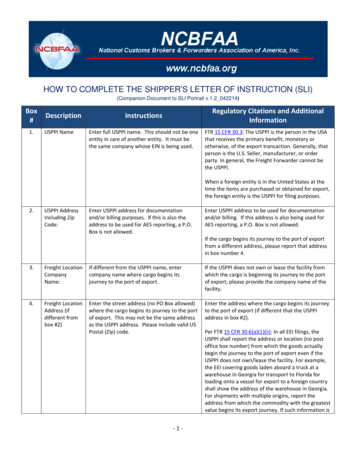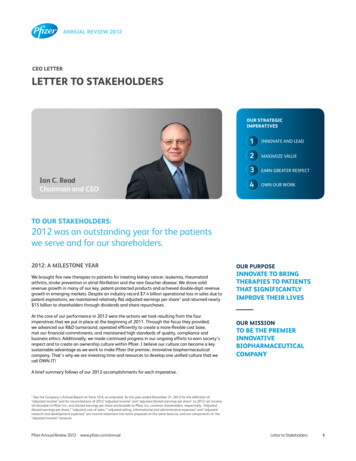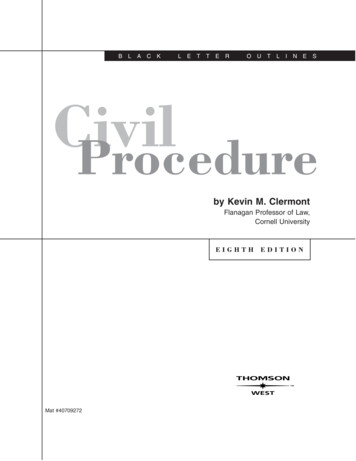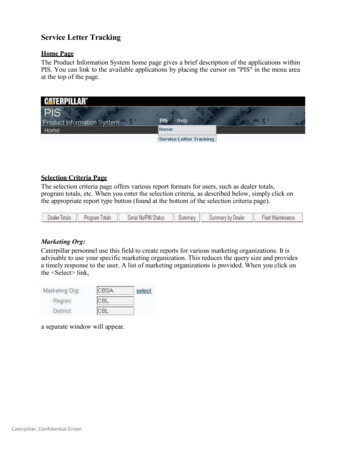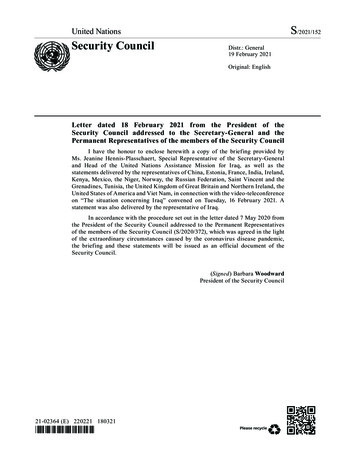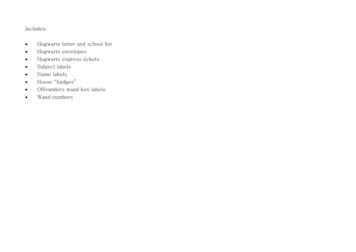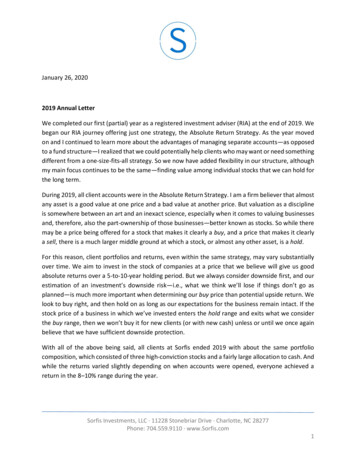
Transcription
January 26, 20202019 Annual LetterWe completed our first (partial) year as a registered investment adviser (RIA) at the end of 2019. Webegan our RIA journey offering just one strategy, the Absolute Return Strategy. As the year movedon and I continued to learn more about the advantages of managing separate accounts—as opposedto a fund structure—I realized that we could potentially help clients who may want or need somethingdifferent from a one-size-fits-all strategy. So we now have added flexibility in our structure, althoughmy main focus continues to be the same—finding value among individual stocks that we can hold forthe long term.During 2019, all client accounts were in the Absolute Return Strategy. I am a firm believer that almostany asset is a good value at one price and a bad value at another price. But valuation as a disciplineis somewhere between an art and an inexact science, especially when it comes to valuing businessesand, therefore, also the part-ownership of those businesses—better known as stocks. So while theremay be a price being offered for a stock that makes it clearly a buy, and a price that makes it clearlya sell, there is a much larger middle ground at which a stock, or almost any other asset, is a hold.For this reason, client portfolios and returns, even within the same strategy, may vary substantiallyover time. We aim to invest in the stock of companies at a price that we believe will give us goodabsolute returns over a 5-to-10-year holding period. But we always consider downside first, and ourestimation of an investment’s downside risk—i.e., what we think we’ll lose if things don’t go asplanned—is much more important when determining our buy price than potential upside return. Welook to buy right, and then hold on as long as our expectations for the business remain intact. If thestock price of a business in which we’ve invested enters the hold range and exits what we considerthe buy range, then we won’t buy it for new clients (or with new cash) unless or until we once againbelieve that we have sufficient downside protection.With all of the above being said, all clients at Sorfis ended 2019 with about the same portfoliocomposition, which consisted of three high-conviction stocks and a fairly large allocation to cash. Andwhile the returns varied slightly depending on when accounts were opened, everyone achieved areturn in the 8–10% range during the year.Sorfis Investments, LLC · 11228 Stonebriar Drive · Charlotte, NC 28277Phone: 704.559.9110 · www.Sorfis.com1
Viewing Client Accounts as Holding CompaniesPhilosophically, we view each client account as a holding company for a permanent, miniconglomerate; and we aim to increase that conglomerate’s earning power over time. While we lookto buy stocks that we think are undervalued to both protect our downside as well as earn extra returnshould the undervaluation re-rate to a fair valuation, our expected returns center around our shareof the earnings of the businesses in which we invest. By way of illustration, consider an example withthe following four izationNet IncomeEarningsper Share(EPS)Company A 515,000,000 75,000,000 7,500,000 0.50Company B 1010,000,000 100,000,000 10,000,000 1.00Company C 2020,000,000 400,000,000 30,000,000 1.50Company D 402,000,000 80,000,000 10,000,000 5.00Now, let’s assume that a client has a portfolio invested in those four companies, along with a cashposition, in the following amounts:Shares Held byClientCompany ACompany BCompany CCompany DCashTotal30,00010,00015,0005,000Total ValueCompany EPS 150,000 100,000 300,000 200,000 250,000 1,000,000 0.50 1.00 1.50 5.00Client’s Shareof CompanyNet Income 15,000 10,000 22,500 25,000 72,500In this example, the client’s total share of the earnings of the companies in which he or she is investedis 72,500. On the total portfolio value of 1,000,000, this would equate to a 7.25% earnings yield, ora 9.67% earnings yield on the capital that is invested and not held in cash ( 72,500/ 750,000).Because we take the mentality of owning the whole company when we invest, we consider that7.25% to be our base, expected return for the year, and the yield we’d compare to a bond yield,Sorfis Investments, LLC · 11228 Stonebriar Drive · Charlotte, NC 28277Phone: 704.559.9110 · www.Sorfis.com2
savings account yield, or other alternative for the capital invested in those businesses. But there area few important caveats to add to that expectation:1. Business earnings can be volatile, hard to predict, and sometimes illusory—but they also havethe benefit of growth. For these reasons, it’s important that we estimate company earningpower by, to use a phrase from value investor Seth Klarman, “compounding multipleconservative assumptions.”2. Our actual return is going to depend on how much of those earnings we receive in cash(dividends), how much is reinvested to grow the businesses, and any change in the multiplethe market assigns to each investee’s valuation. As such, it’s important to think hard about acompany’s reinvestment prospects, as well as the valuation the market is assigning to thoseprospects.3. As the example shows, cash can be a significant drag on expected performance, but it alsogives one the benefit of optionality if a great opportunity comes along. Over the long term,the value of cash is nearly guaranteed to decline via inflation, so for us, cash is not a longterm, strategic allocation, but rather a temporary allocation until we can find an investmentthat meets our investment criteria. There will be times when we hold a large amount of cash,possibly for years, and times when we hold almost none.All of the above may make our investment process sound mathematical and precise, but it is not.There is art to the investment process, which gets painted by the judgment that comes from someloose combination of experience, effort, and luck. Our job is to deploy client capital the best we can,given the opportunities at hand among those we can understand, all while trying to get a little morecapable of doing it well as we go along.Holdings UpdateBecause all clients ended the year with the same three holdings, below are overviews of thoseinvestments.Tandy Leather Factory, Inc.Tandy Leather Factory is a specialty retailer of leather and leathercraft-related items. Leather is 40%of sales, hand tools 20% of sales, and then there are a bunch of items that make up a single-digitpercent of sales (dyes, finishes, glues, hardware, kits, stamping tools, etc.). It is basically a one-stopshop, and by far the largest player in this niche.Sorfis Investments, LLC · 11228 Stonebriar Drive · Charlotte, NC 28277Phone: 704.559.9110 · www.Sorfis.com3
I’ve followed Tandy for nearly 15 years, although it had been almost a decade since I’d owned sharesin the company—until last year. The catalyst for becoming a shareholder once again occurred duringthe fourth quarter of 2018, when the company made both a management and strategy change. Ithink the previous management team, comprised of longtime company veterans, did a good job overthe years, but as is often the case, especially in the micro-cap world, it put too much emphasis ontop-line growth rather than economically profitable growth. And when cash flow slowed a bit, thisteam started trying new things such as starting a district manager program; continuing to operate theinternational stores which lacked scale and were unprofitable; and taking a shot at some otherinitiatives that may have been reasonable experiments, but resulted in poor returns on investment(conference sponsorships, opening on Sundays, etc.). More expectations were also put on storemanagers to get out and sell non-retail / commercial business, which took them away from runningtheir stores and providing great customer service to the retail customer base.The new management team is more focused on cash flow and is updating company technology thatwas in need of a refresh, such as point-of-sale and accounting systems. During this refresh, thecompany noticed some accounting issues, and opened an independent investigation into thevaluation and expensing of inventories, which has delayed it from filing its last two quarterly reportsand caused a significant drop in the stock price when it was all announced.After following the company and previous management for more than a decade, I thought theaccounting issues were unlikely to be anything major that would impair either the earnings power ofthe business or the cash in the bank—which was equal to almost half of the market cap (the companyis also debt free). The issue seemed likely to be related to the technology upgrades and unlikely to beanything major, but because I couldn’t know for sure, I only added slowly to the position on the waydown. When the company announced an update in October 2019, which showed that the issues werein fact quite minor, as well as a business that continued to generate cash during the first 9 months ofthe year, I thought the stock price was going to open up well above 5 per share the following day.When it didn’t, and because I judged that the odds of being right about our thesis had significantlyincreased, and the odds of losing money significantly decreased, I added to our position, and made itour largest holding by a decent margin.The market hates uncertainty, and the best opportunities for us will often come when an uncertainopportunity comes wrapped in a package with downside protection. The time we’ve spent followingthe company and management over the years, our high regard for its Board of Directors, and thecompany’s balance sheet, gave us the information we needed to invest and then make it our largestposition, even though we’re still awaiting updated company financials.Sorfis Investments, LLC · 11228 Stonebriar Drive · Charlotte, NC 28277Phone: 704.559.9110 · www.Sorfis.com4
Tandy’s share price moved up a bit at yearend, and the company ended 2019 with a market cap ofabout 51 million. The cash balance at the end of September was 22.6 million, and we estimate thatthe after-tax earning power of the company is somewhere between 5 million and 9 million. At ouraverage cost, we believe we bought shares below the liquidation value of the company and at asingle-digit multiple of after-tax earnings (i.e., at a double-digit earnings yield).While we prefer to mostly focus on the downside and use earnings yield as a base return, we do liketo get a sense of likely upside and fair value. Multiples of small, private businesses with 5 millionin EBITDA that 1) have a good competitive position; 2) aren’t necessarily growth businesses; and 3)also aren’t too capital intensive, tend to sell for 6–8x EBITDA. Assuming a 12.5% normalized operatingmargin—which is on the lower end of Tandy’s margin from 2012 to 2016—and 80 million of sales,we get 10 million in operating earnings plus about 1.8 million in depreciation and amortization, so 11.8 million in EBITDA. Based on comparables, this would give us a valuation range of 70.8 millionto 94.4 million. Assuming 9 million shares outstanding (i.e., buybacks roughly offset issued restrictedshares), and 1 to 2 per share in excess cash at yearend, we’d get a fair valuation somewhere in the 8.85 to 12.50 per share range.Cambria Automobiles plcCambria Automobiles is a multi-brand auto dealership in the United Kingdom. It was established in2006 with a focus on buying and turning around underperforming dealerships. The company raised 10.8 million to get started, which is the only outside capital it has raised. The company is run by anowner-operator in Chief Executive Officer Mark Lavery, who owns 40% of the shares outstanding andhas never sold a share, which includes the 2010 initial public offering (IPO). Cambria currently has 27dealerships representing 41 franchises and 16 brand partners.The company underwent a transformation in its focus beginning in 2014 with the purchase of theBarnet Jaguar Land Rover (JLR) business. Prior to 2014, the company had only 0.3 million of goodwillon the balance sheet, as it had basically turned dealerships that were losing money, which it hadbought at or below book value, into a business making more than 4 million in operating profit. Itpaid a premium to book value in the Barnet acquisition, as well as for a couple of subsequentacquisitions, in order to deepen its exposure to the JLR brand as well as work toward increasingfurther exposure to the High Luxury Segment (HLS) of the market. Cambria also made it a priority toupgrade its overall real estate portfolio.While the company has continued to look for acquisitions, it’s been disciplined about not overpaying,and has instead looked to develop its plans by trying to earn new greenfield projects (essentiallySorfis Investments, LLC · 11228 Stonebriar Drive · Charlotte, NC 28277Phone: 704.559.9110 · www.Sorfis.com5
another form of acquisition, without paying goodwill). This effort has started to pay off, as evidencedin 2018 when the company was awarded five new HLS dealerships (one McLaren, two Bentley, andtwo Lamborghini). The HLS segment is especially attractive because it is less cyclical, and much of theinventory gets sold before the cars even come to market because those manufacturers limit supplyand generally have waiting lists for many of their new models.The company experienced some disruption to operations as the real estate development and refranchising occurred. But most of that is now behind it, and it has now occupied the major sites thatwere under development. This has started to show up in the numbers, as the company reported asignificant improvement in results for the fiscal year ended August 31, 2019, both compared to itsown previous results and compared with the rest of the industry, as the overall new car market in theUnited Kingdom has remained difficult. In fiscal 2019, the company saw a 4.4% increase in revenueto 657.8 million, and a 24.7% i
Sorfis Investments, LLC · 11228 Stonebriar Drive · Charlotte, NC 28277 Phone: 704.559.9110 · www.Sorfis.com 5 Tandy’s share price moved up a bit at yearend, and the company ended 2019 with a market cap of about 51 million. The cash balance at the end of

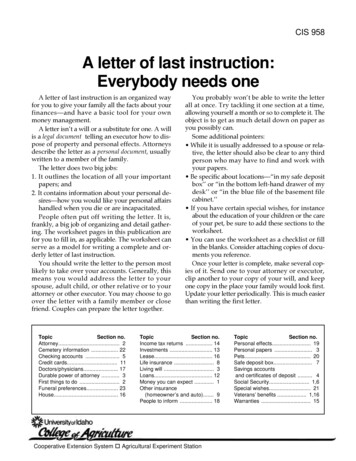
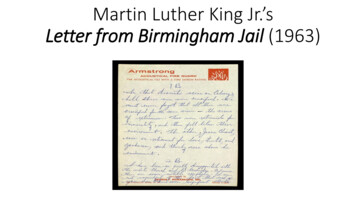
![Letter from Birmingham Jail (1963) [Abridged]](/img/2/1963-mlk-letter-abridged.jpg)
